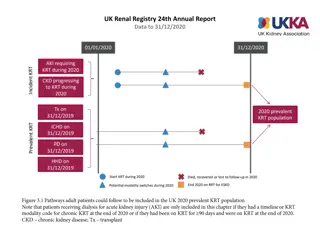Renal Involvement in Systemic Diseases
The kidneys can be directly or secondarily affected by various systemic diseases. Conditions like diabetes mellitus and systemic lupus erythematosus can lead to significant renal involvement, presenting with different manifestations and stages. Understanding these implications is crucial for proper management and diagnosis in clinical practice.
Download Presentation

Please find below an Image/Link to download the presentation.
The content on the website is provided AS IS for your information and personal use only. It may not be sold, licensed, or shared on other websites without obtaining consent from the author.If you encounter any issues during the download, it is possible that the publisher has removed the file from their server.
You are allowed to download the files provided on this website for personal or commercial use, subject to the condition that they are used lawfully. All files are the property of their respective owners.
The content on the website is provided AS IS for your information and personal use only. It may not be sold, licensed, or shared on other websites without obtaining consent from the author.
E N D
Presentation Transcript
University of University of Basrah Al Al- -Zahraa ZahraaMedical College and Scientific Research Medical College and Scientific Research Basrah Ministry of Higher education Ministry of Higher education Block: Metabolic block Lecture: Renal involvement in systemic disease Lecturer: Dr.MohammedAdel Block staff: Dr.Ahmed jaafer (block leader) Dr. Daihgum imad mohammed Dr.Ahmed qasim Dr.Ahmed ibraheem Dr. Majid hameed Dr. Mohammed mehdi dr. mohammedAdel Dr .Ammar Davidson's Principles and Practice of Medicine HARRISON S PRINCIPLES OF INTERNALMEDICINE WILLIAMS textbook of ENDOCRINOLOGY PEDIATRIC PRACTICE Endocrinology Oxford Handbook of Endocrinology and Diabetes
Renal involvement in systemic conditions: The kidneys may be directly involved in a number of multisystem diseases or secondarily affected by diseases of other organs. Involvement may be at a pre-renal, renal (glomerular or interstitial) or post-renal level.
Diabetes mellitus Diabetic nephropathy is the most common cause of CKD in developed countries. In patients with diabetes, there is a steady advance from moderately elevated albuminuria (microalbuminuria) to dipstick-positive proteinuria, in association with evolving hypertensive and progressive renal failure. Few patients require renal biopsy to establish the diagnosis, but atypical features such as very rapid progression of proteinuria/decline in renal function or the absence of other microvascular damage, including retinopathy, should lead to suspicion that an alternative condition could be present. Management with ACE inhibitors and ARBs to slow progression. Emerging evidence suggests that SGLT2 inhibitors, such as empagliflozin, a new agent for diabetes that causes glycosuria
Stages Of Diabetic Nephropathy
Systemic lupus erythematosus Subclinical renal involvement, with non-visible haematuria and proteinuria but minimally impaired or normal renal function, is common in systemic lupus erythematosus (SLE). Usually, this is due to glomerular disease, although interstitial nephritis may also occur, particularly in patients with overlap syndromes such as mixed connective tissue disease and Sj gren s syndrome. Almost any histological pattern of glomerular disease can be observed in SLE and the clinical presentation ranges from florid, rapidly progressive glomerulonephritis to nephrotic syndrome. The most common presentation is with subacute disease and inflammatory features (haematuria, hypertension, variable renal impairment), accompanied by heavy proteinuria that often reaches nephrotic levels.
Vasculitis: Small-vessel vasculitis commonly affects the kidneys, with rapid and profound impairment of glomerular function. Histologically, there is a focal inflammatory glomerulonephritis, usually with focal necrosis. and often with crescentic changes. Typically, the patient is systemically unwell with an acute phase response, weight loss and arthralgia. In some patients, it presents as a kidney-limited disorder, with rapidly deteriorating renal function and crescentic nephritis (a rapidly progressive glomerulonephritis). In others, pulmonary haemorrhage may occur, which can be life- threatening.
The most important cause is ANCA vasculitis. Two subtypes are recognised microscopic polyangiitis (MPA),and granulomatosis with polyangiitis. Both may present with glomerulonephritis and pulmonary haemorrhage, along with constitutional symptoms, Gastrointestinal involvement and neuropathy may also occur. Serological testing for antibodies to myeloperoxidase (MPO) and proteinase 3 (PR3) is usually positive but these are not specific and a biopsy of affected tissue should be obtained, if possible, to confirm the diagnosis.
The standard treatment of glomerulonephritis associated with systemic vasculitis is high- dose glucocorticoids combined with cyclophosphamide, or mycophenolate mofetil. Recent studies indicate that rituximab when combined with highdoseglucocorticoids, is as effective as oral cyclophosphamide and high-dose glucocorticoids in the treatment of ANCA-associated vasculitis. Plasma exchange can offer additional benefit in patients with progressive renal damage who are not responding adequately to immunosuppressive therapy.























